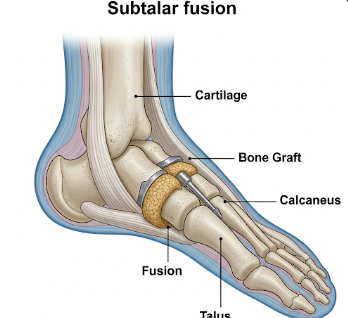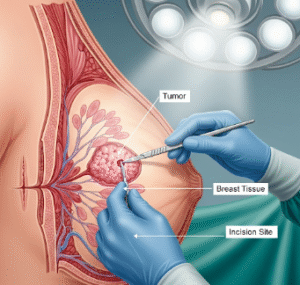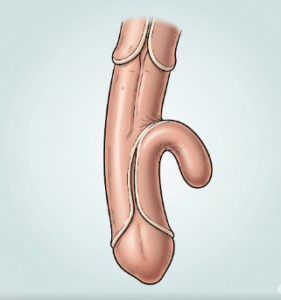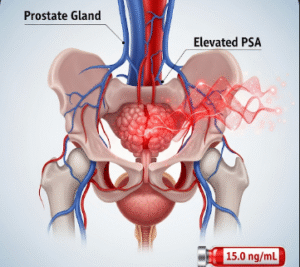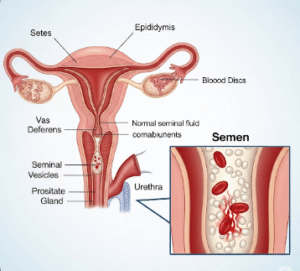Overview
Subtalar fusion is a surgical procedure aimed at stabilizing the subtalar joint, which is located below the ankle and helps with side-to-side movement of the foot. This surgery is primarily performed to relieve chronic pain and instability caused by conditions such as arthritis, trauma, or congenital deformities.
In Korea, subtalar fusion is offered in advanced orthopedic and foot & ankle centers, combining minimally invasive techniques, expert surgeons, and state-of-the-art rehabilitation programs. Patients worldwide choose Korea for this surgery due to high success rates and short recovery times.
What is Subtalar Fusion?
Subtalar fusion involves joining the talus and calcaneus bones in the foot to eliminate motion in the subtalar joint. This fusion stabilizes the foot, reduces pain, and improves walking ability.
Key types of subtalar fusion include:
- ✦ Open fusion – traditional surgical approach with larger incision.
- ➤ Arthroscopic (minimally invasive) fusion – uses small incisions and cameras for precise alignment and faster recovery.
This surgery is generally recommended for patients with severe arthritis, post-traumatic deformities, or chronic instability unresponsive to conservative treatment.
What are the Benefits?
Subtalar fusion provides several important benefits:
✅ Pain relief – eliminates chronic pain caused by joint degeneration or deformity.
➤ Improved stability – reduces the risk of ankle sprains and falls.
✦ Restores functional walking – especially for patients with uneven gait.
➤ Long-term durability – fused joint prevents further damage.
✅ Minimally invasive options – faster recovery and less post-operative pain.
✦ Corrects deformities – such as flatfoot or hindfoot misalignment.
Procedure Details
1) How should I prepare for Subtalar Fusion?
Preparation steps include:
- ✦ Medical evaluation – X-rays, CT scans, or MRI to assess the joint and surrounding structures.
- ➤ Blood tests and anesthesia assessment.
- ✦ Medication adjustments – stopping blood thinners or anti-inflammatory drugs.
- ➤ Discussion with your surgeon regarding type of fusion, expected recovery, and potential risks.
- ✦ Fasting for 6–8 hours prior to surgery.
- ➤ Pre-operative physical therapy guidance – to maintain strength and mobility before surgery.
2) What happens during the procedure Subtalar Fusion?
The surgery typically lasts 1–2 hours under general or regional anesthesia:
➤ Step 1: An incision is made over the subtalar joint (or small arthroscopic portals for minimally invasive surgery).
✦ Step 2: Cartilage from the joint surfaces is removed to prepare for fusion.
➤ Step 3: Bone grafts (from the patient or donor) may be inserted to promote fusion.
✦ Step 4: Screws, plates, or other fixation devices are used to hold the bones in position.
➤ Step 5: Incisions are closed, and a sterile dressing or cast is applied.
Arthroscopic fusion reduces tissue damage and speeds up recovery while maintaining the same success rates as open surgery.
3) What happens after a Subtalar Fusion?
Post-operative care involves:
- ✦ Hospital stay: usually 1–3 days for monitoring.
- ➤ Pain management – medications to control post-surgical pain.
- ✦ Immobilization – a cast, boot, or splint is used for 6–12 weeks.
- ➤ Non-weight bearing initially, progressing to partial weight-bearing as directed by the surgeon.
- ✦ Physical therapy – gradual strengthening and range-of-motion exercises once the joint is stable.
- ➤ Follow-up imaging – X-rays to confirm successful bone fusion.
Most patients can resume light activities within 3 months and full activity in 6–12 months depending on healing.
Risks / Benefits
Potential Risks:
- ✦ Infection at the surgical site.
- ➤ Delayed bone fusion (nonunion) or malunion.
- ✦ Nerve irritation or damage causing numbness or tingling.
- ➤ Blood clots or swelling in the lower leg.
- ✦ Persistent pain or stiffness if fusion fails.
Benefits:
- ✅ Eliminates chronic subtalar joint pain.
- ✅ Stabilizes the foot and improves walking function.
- ✅ Long-term durability and reduced risk of further joint damage.
- ✅ Corrects foot deformities and restores alignment.
Recovery and Outlook
Recovery is gradual but predictable with proper care:
- ➤ Hospital stay: 1–3 days.
- ✦ Immobilization: 6–12 weeks with cast or boot.
- ➤ Weight-bearing: gradual progression under medical supervision.
- ✦ Full recovery: typically 6–12 months.
- ➤ Long-term outcome: Most patients experience significant pain relief, improved stability, and functional walking.
When To Call the Doctor
Patients should contact their healthcare provider if they notice:
⚠ Severe or increasing pain not relieved by medication.
⚠ Redness, swelling, pus, or fever (signs of infection).
⚠ Numbness, tingling, or weakness in the foot.
⚠ Problems with wound healing or cast complications.
⚠ Difficulty walking beyond expected post-operative limitations.
Best Korea Option / Process
Korea offers high-quality subtalar fusion care with the following advantages:
- ✦ Expert orthopedic and foot & ankle surgeons trained in arthroscopic and open techniques.
- ➤ State-of-the-art hospitals equipped with modern imaging, navigation, and surgical tools.
- ✦ Minimally invasive options for faster recovery and less post-operative pain.
- ➤ Comprehensive post-operative rehabilitation programs.
- ✦ Affordable treatment packages compared to the US or Europe.
- ➤ Multidisciplinary care ensuring optimal recovery and functional outcomes.
Korea is an excellent destination for patients seeking safe, advanced subtalar fusion with expert guidance and high success rates.
Highlights of Subtalar Fusion in Korea
- ✅ Relieves chronic pain from subtalar joint arthritis or deformities.
- ➤ Provides long-term joint stabilization.
- ✦ Minimally invasive techniques for faster recovery.
- ➤ Performed by leading Korean orthopedic specialists.
- ✅ Comprehensive post-operative care with excellent outcomes.

